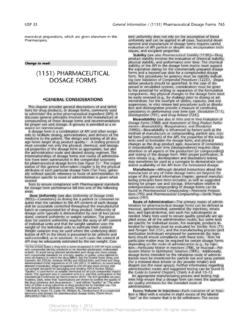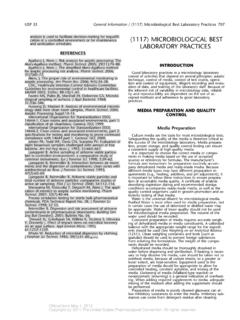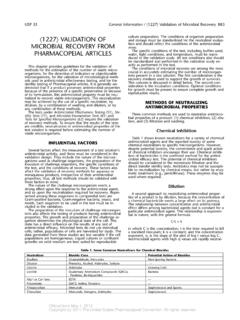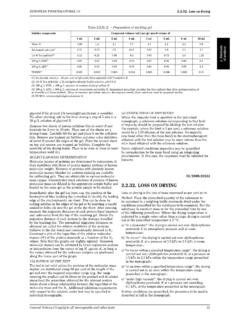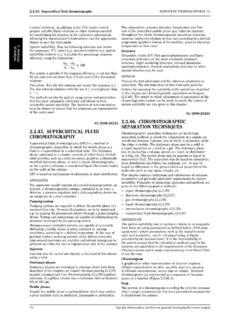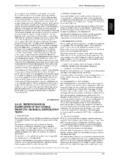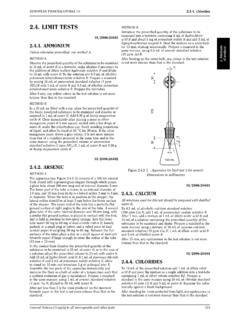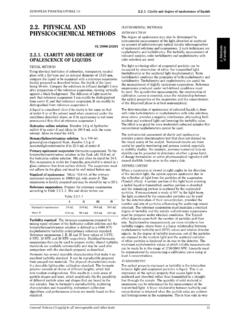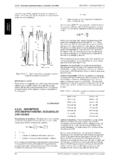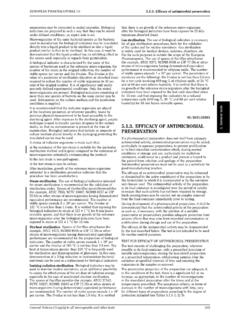Transcription of <1111> MICROBIOLOGICAL EXAMINATION OF NONSTERILE …
1 USP 35 General Information / 1111 MICROBIOLOGICAL , H, and J Wells, Powder sampling. Drug Good Manufacturing Practice during the manufacture,Ind. Pharm., 2002, 28(2): pp. 107 , and distribution of pharmaceutical EXAMINATION of NONSTERILE products is performedaccording to the methods given in the texts on MicrobialEnumeration Tests 61 and Tests for Specified Microorganisms 62 . Acceptance criteria for NONSTERILE pharmaceutical prod-ucts based upon the total aerobic microbial count (TAMC)and the total combined yeasts and molds count (TYMC) aregiven in Tables 1 and 2.
2 Acceptance criteria are based on 1111 MICROBIOLOGICAL individual results or on the average of replicate counts whenreplicate counts are performed ( , direct platingEXAMINATION OF NONSTERILE methods).When an acceptance criterion for MICROBIOLOGICAL qualityPRODUCTS: ACCEPTANCEis prescribed, it is interpreted as follows: 101 cfu: maximum acceptable count = 20;CRITERIA FOR pharmaceutical 102 cfu: maximum acceptable count = 200; 103 cfu: maximum acceptable count = 2000; and soPREPARATIONS 1 includes a list of specified microorganisms forSUBSTANCES FORwhich acceptance criteria are set.
3 The list is not necessarilyexhaustive, and for a given preparation it may be necessaryPHARMACEUTICAL USEto test for other microorganisms depending on the natureof the starting materials and the manufacturing it has been shown that none of the prescribed tests willThe presence of certain microorganisms in nonsterileallow valid enumeration of microorganisms at the level pre-preparations may have the potential to reduce or even inac-scribed, a validated method with a limit of detection astivate the therapeutic activity of the product and has a po-close as possible to the indicated acceptance criterion istential to adversely affect the health of the patient.
4 Have therefore to ensure a low bioburden offinished dosage forms by implementing current guidelinesTable 1. Acceptance Criteria for MICROBIOLOGICAL Quality of NONSTERILE Dosage FormsTotal AerobicTotal CombinedMicrobial CountYeasts/Molds(cfu/g orCount (cfu/g orRoute of Administrationcfu/mL)cfu/mL)Specified Microorganism(s)Nonaqueous preparations for oral use103102 Absence of Escherichia coli (1 g or 1 mL)Aqueous preparations for oral use102101 Absence of Escherichia coli (1 g or 1 mL)Rectal use103102 Absence of Staphylococcus aureus (1 g or 1 mL)Oromucosal use102101 Absence of Pseudomonas aeruginosa (1 g or1 mL)
5 Absence of Staphylococcus aureus (1 g or 1 mL)Gingival use102101 Absence of Pseudomonas aeruginosa (1 g or1 mL)Absence of Staphylococcus aureus (1 g or 1 mL)Cutaneous use102101 Absence of Pseudomonas aeruginosa (1 g or1 mL)Absence of Staphylococcus aureus (1 g or 1 mL)Nasal use102101 Absence of Pseudomonas aeruginosa (1 g or1 mL)Absence of Staphylococcus aureus (1 g or 1 mL)Auricular use102101 Absence of Pseudomonas aeruginosa (1 g or1 mL)Absence of Pseudomonas aeruginosa (1 g orVaginal use1021011 mL)Absence of Staphylococcus aureus (1 g or 1 mL)Absence of Candida albicans (1 g or 1 mL)Absence of Staphylococcus aureus (1 patch)Transdermal patches (limits for one102101patch including adhesive layer andAbsence of Pseudomonas aeruginosa (1 patch)backing)Absence of Staphylococcus aureus (1 g or 1 mL)Inhalation use (special requirements ap-102101ply to liquid preparations for nebuliza-Absence of Pseudomonas aeruginosa (1 g ortion)1 mL)Absence of bile-tolerant Gram-negative bacteria(1 g or 1 mL)
6 Official from May 1, 2012 Copyright (c) 2011 The United States Pharmacopeial Convention. All rights from by nEwp0rt1 on Sat Dec 03 00:30:19 EST 2011692 1111 MICROBIOLOGICAL EXAMINATION / General InformationUSP 35 Table 2. Acceptance Criteria for MICROBIOLOGICAL Quality of Non-Low water activity has traditionally been used to controlsterile Substances for pharmaceutical Usemicrobial deterioration of foodstuffs. Examples where theavailable moisture is reduced are dried fruit, syrups, andTotal Combinedpickled meats and vegetables.
7 Low water activities make Yeasts/Moldsthese materials self-preserved. Low water activity will alsoTotal AerobicCountprevent microbial growth within pharmaceutical drug prod- Microbial Count (cfu/g or cfu/ucts. Other product attributes, for example, low or high pH, (cfu/g or cfu/mL)mL)absence of nutrients, presence of surfactants, and additionSubstances for103102of antimicrobial agents, as well as low water activity, help topharmaceutical useprevent microbial growth. However, it should be noted thatmore resistant microorganisms, including spore-formingIn addition to the microorganisms listed in Table 1, theClostridium spp.
8 , Bacillus spp., Salmonella spp. and filamen-significance of other microorganisms recovered should betous fungi, although they may not proliferate in a drugevaluated in terms of the following: product with a low water activity, may persist within the The use of the product : hazard varies according to of administration (eye, nose, respiratory tract).When formulating an aqueous oral or topical dosage The nature of the product : does the product supportform, candidate formulations should be evaluated for watergrowth? does it have adequate antimicrobialactivity so that the drug product may be self-preserving, ifpreservation?
9 Possible. For example, small changes in the concentration of The method of chloride, sucrose, alcohol, propylene glycol, or glyc- The intended recipient: risk may differ for neonates, in-erin in a formulation may result in the creation of a drugfants, the with a lower water activity that can discourage the Use of immunosuppressive agents, of microorganisms in the product . This is par- The presence of disease, wounds, organ valuable with a multiple-use product that may beWhere warranted, a risk-based assessment of the relevantcontaminated by the user.
10 Packaging studies should be con-factors is conducted by personnel with specialized trainingducted to test product stability and to determine that thein microbiology and in the interpretation of microbiologicalcontainer closure system protects the product from mois-data. For raw materials, the assessment takes account of theture gains that would increase the water activity duringprocessing to which the product is subjected, the of testing, and the availability of materials of theReduced microbial limits testing may be justified throughdesired assessment.
